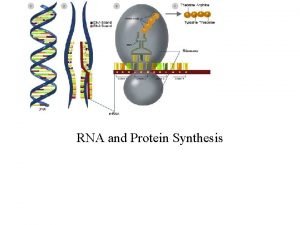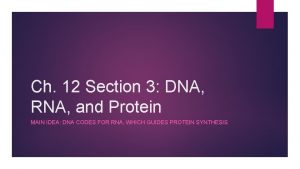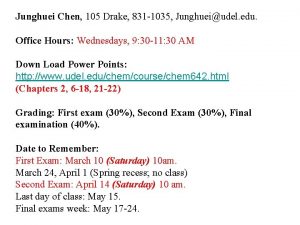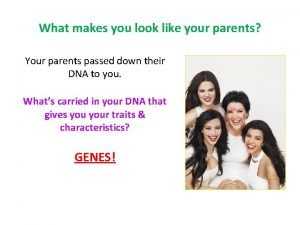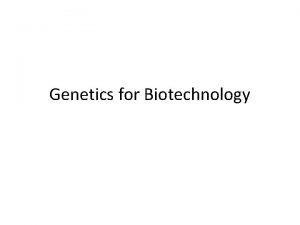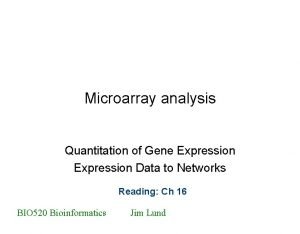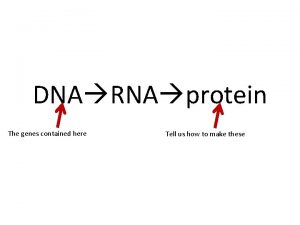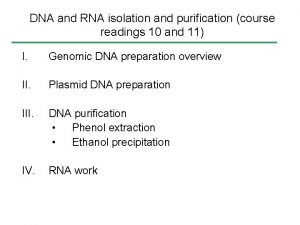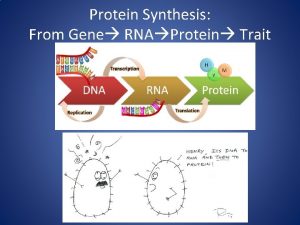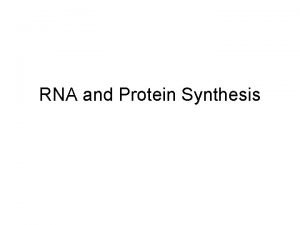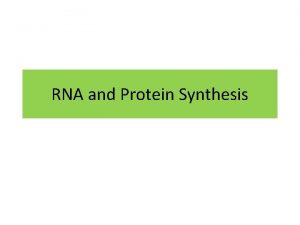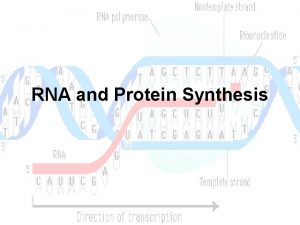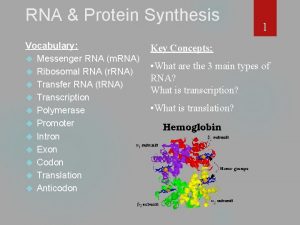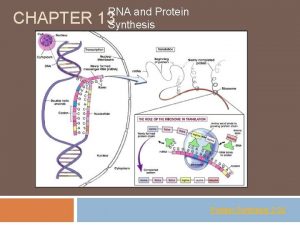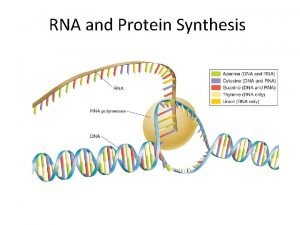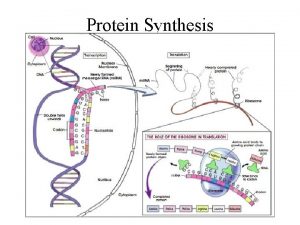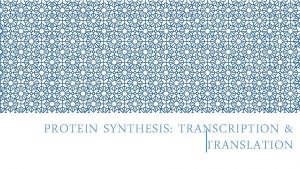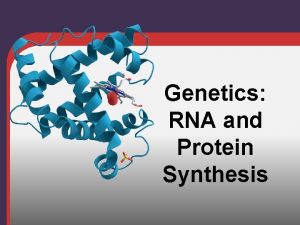Chapter 13 RNA Protein Synthesis MS LUACES HONORS















- Slides: 15

Chapter 13 – RNA & Protein Synthesis MS. LUACES HONORS BIOLOGY

13. 1 RNA also consists of a long chain of nucleotides, but it puts the genetic code into action Uses DNA to translate instructions and direct production of proteins Some important differences between DNA & RNA: The sugar in RNA is ribose instead of deoxyribose Single-stranded instead of double-stranded Contains uracil in place of thymine

13. 1 RNA DNA is the master plan, while RNA is the copied blueprint – contains only the instructions needed to build a certain area (protein)

13. 1 RNA Functions and types of RNA: Messenger RNA (m. RNA): carries copies of instructions from DNA to other parts of the cell Ribosomal RNA (r. RNA): make up ribosome molecules where protein is made Transfer RNA (t. RNA): transfers amino acids to ribosome to build the protein

13. 1 RNA Transcription: segments of DNA serve as templates to produce complementary RNA molecules (translate DNA) Happens in the nucleus of eukaryotic cells Requires enzyme RNA Polymerase which binds to DNA and separates the strands, then translates one of the strands by adding complementary bases

13. 1 RNA How does it know where to start or stop transcription? Promoters (regions of DNA with specific base sequences) signal RNA Polymerase exactly where to start making RNA Stop areas signal RNA Polymerase transcription is finished

13. 1 RNA Once transcription has finished, editing has to be made to the pre-m. RNA molecule to get rid of introns (junk DNA) Portions that are not junk are called exons – these are put back together and exit the nucleus into the cytoplasm to find a ribosome and begin making the protein

13. 2 Ribosomes & Protein Synthesis The genetic code is read 3 “letters” at a time, so that each “word” is 3 bases long and corresponds to a single amino acid “Letters” are the bases of RNA – A, G, C, U “Words” are codons – ex: AGU, CAU, GGC which code for amino acids. Amino acids (there are 20) that are joined together into long chains (polypeptides) make proteins.

13. 2 Ribosomes & Protein Synthesis There are 64 possible 3 -base codons in the genetic code, in which some amino acids are specified by more than one codon Ex: Tryptophan is only coded by UGG, but Tyrosine can be coded by UAU or UAC The properties of the protein depend on the order of amino acids, which determines the shape and function

13. 2 Ribosomes & Protein Synthesis How do we know when to start or stop translation? There are start (AUG) and stop (3 different ones) codons at the beginning and end of the m. RNA molecule being translated

13. 2 Ribosomes & Protein Synthesis Ribosomes use the sequence of codons in m. RNA to assemble amino acids into polypeptide chains. This decoding process is known as translation Once the polypeptide is complete, it will fold into its final shape or join with other polypeptides to become a functional protein

13. 2 Ribosomes & Protein Synthesis

13. 2 Ribosomes & Protein Synthesis Steps in Translation: 1. In the cytoplasm, the ribosome attaches to an m. RNA molecule 2. Each codon is read, and sends for a t. RNA molecule with an anticodon (complementary base) to retrieve the amino acid 3. The t. RNA molecule binds to the ribosome, adding the amino acid through peptide bonds into a polypeptide chain that continues to grow 4. When the STOP codon is reached, the ribosome releases both the newly formed polypeptide and the m. RNA molecule. Translation is complete.

13. 2 Ribosomes & Protein Synthesis All 3 types of RNA are involved in translation Surprisingly, most organisms share the same genetic code, and therefore, the same codon reading and amino acids!! Why we can make bacteria make our insulin The central dogma of molecular biology is that information is transferred from DNA RNA Protein Many proteins are enzymes that carry out functions in our bodies Sometimes, the dogma can be reversed: HIV has RNA that becomes DNA in human immune cells

https: //www. youtube. com/watch? v=h 3 b 9 Arup. XZg https: //www. youtube. com/watch? v=6 g. UY 5 No. X 1 Lk
 Rna protein synthesis
Rna protein synthesis Section 12 3 rna and protein synthesis answers
Section 12 3 rna and protein synthesis answers Messenger rna codons
Messenger rna codons Dna rna and protein synthesis study guide
Dna rna and protein synthesis study guide Dna rna protein synthesis homework #2 dna replication
Dna rna protein synthesis homework #2 dna replication Rna transfer
Rna transfer Chapter 12 section 3 dna rna and protein
Chapter 12 section 3 dna rna and protein Synthesis of rna
Synthesis of rna Que es
Que es Central dogma
Central dogma Microarray analysis
Microarray analysis Dna rna protein
Dna rna protein Dna rna protein diagram
Dna rna protein diagram Protein
Protein Restaurant analogy
Restaurant analogy Transcription and translation
Transcription and translation





